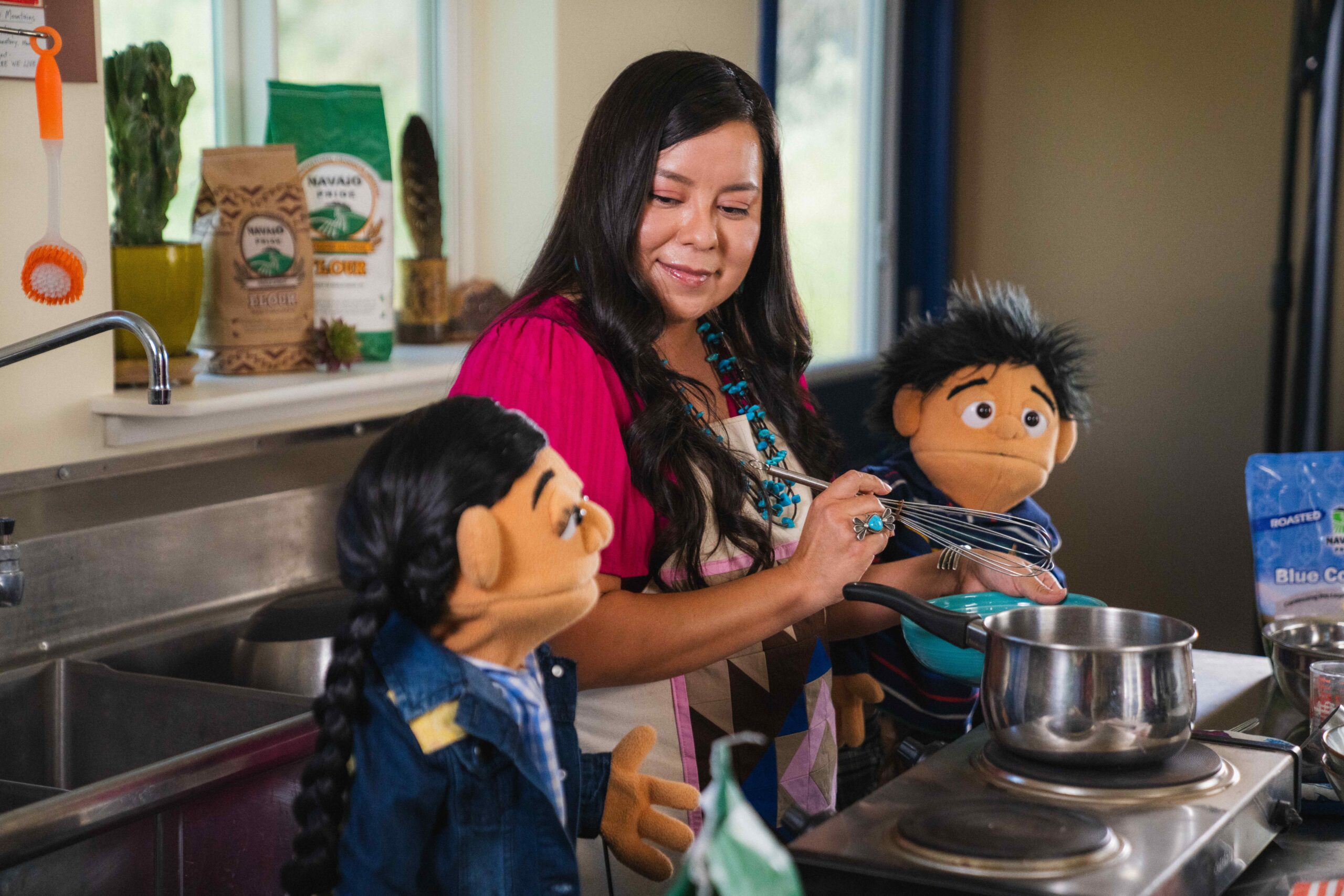Some information may be outdated.
Pete Sands is bringing Navajo culture and language to life with “Navajo Highways,” a new kids’ show featuring puppets and live actors.
On a T.V. set outside Star Hall, Moab’s Pete Sands holds up a puppet with long, black hair, a cowboy hat and a red button-up shirt. The puppet, Uncle Al, is one of three that Sands voices in “Navajo Highways,” the new kids’ show he wrote and directed. The show features Sesame Street-esque puppets and live actors, who teach viewers the Navajo language and culture.





Sands, who grew up in Montezuma Creek, Utah on the Navajo Reservation, is a musician, actor and filmmaker — among other talents. He made a special appearance in the drama series “Yellowstone,” which premiered in 2018. But Sands had always wanted to create a production of his own.
“I always felt like I could do it,” Sands said. “I just needed time.”
The idea of Navajo Highways started brewing in Sands’ mind around 2019, when he met with the Sesame Street team in New York. Then, in 2020, when the pandemic hit, Sands started a COVID-19 relief program for the Navajo Nation. He worked to help deliver food and firewood, haul water and set up pop-up testing sites on the reservation.
“One thing I noticed being out in the reservation is the language disparity between the young kids and their elders,” Sands said. “I would go to these places, and the kids would ask me, ‘hey, can you speak Navajo? We’re trying to get our car keys from our grandma, and we don’t know how to talk to her. She doesn’t understand English, and we can’t speak Navajo.’”
The Navajo language has seen a dramatic decline over the past few decades. In 1980, 93 percent of Navajos spoke the language, according to the Navajo Times. By 2010, that had declined to just 51 percent. Much of this language and culture loss can be attributed to centuries of federal policies that forced assimilation on Navajo and other Native peoples.
“The public schools punished people for speaking the language. There were federal policies like a relocation, where families were encouraged to leave the reservation and go to places like Los Angeles, Denver, Albuquerque, Phoenix,” executive producer Daryl Ross Begay said. “So over time, those Navajo families didn’t didn’t speak the language to their descendants.”
Sands was particularly inspired when he went into an elementary school classroom and watched a teacher attempt to get the attention of her unruly students.
“She was trying to tell her kids to clean up the classroom, and they weren’t listening to her. So she went to her desk, and she pulled out a hand puppet, and she started talking with the hand puppet, and then the little kids listened to the puppet,” he said. “In that moment, this light went off in my head. I’m like, ‘wait a minute, maybe I can use puppets to introduce language.’”
Sands began performing live puppet shows at conferences, schools and around Moab to entertain and educate kids.
“People took notice of it,” Sands said. Begay, who he had met on the “Yellowstone” set, encouraged him to make it into a T.V. show.
The show centers around the main puppet, Sadie, a city slicker who journeys to the Navajo Reservation to stay with her grandmother during her summer break. Over six 15 to 20-minute episodes, Sadie learns more about Navajo culture, language and traditions from her community in the fictitious town of Mitten Creek.
“All the stories come from personal experiences as a child,” Sands says. “Every character is based on somebody I know.”
The Navajo Highways crew shot all six episodes of the first season in Moab in just six days at the beginning of June. Shooting locations included Star Hall, Castle Valley and the KZMU office — where Sands hosts his weekly radio show.
“If you ever walk in there, it’s like somebody built that place for a sitcom,” Sands said. “I wanted to shoot there so bad. I created a DJ character.”
The show features guest appearances from Navajo role models, including actor Raoul Trujillo, former UFC champion Nicco Montaño and Alana Yazzie, creator of the blog The Fancy Navajo. Even Helen M. Knight Elementary’s Assistant Principal Libby Bailey had a guest star role.
Sands has big ideas for the show — he wants to introduce more characters, have the puppets visit other tribes and watch them grow over the years.
“I want the puppets to age. Sadie is 10 years old now. In 10 years, I want her to be 20, going to college. Or maybe she leaves Navajo Highways because she’s going to college. There’s a whole new group of puppets that come in,” he said. “So I like that idea of people growing with the show, because a new generation of kids will watch it with new characters that they know.”
But pretty soon — maybe after Season 2 — he wants to hand the show off to the next generation of filmmakers.
“That’s the dream, to have it keep going and have future generations running it,” he said. “I’m just laying the foundation.”
Navajo Highways will air on Navajo Nation TV and be released on YouTube in the fall.
Appreciate the coverage? Help keep local news alive.
Chip in to support the Moab Sun News.





